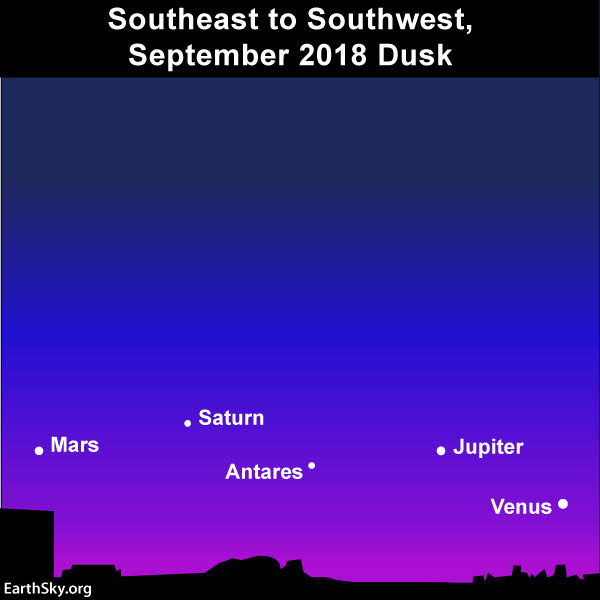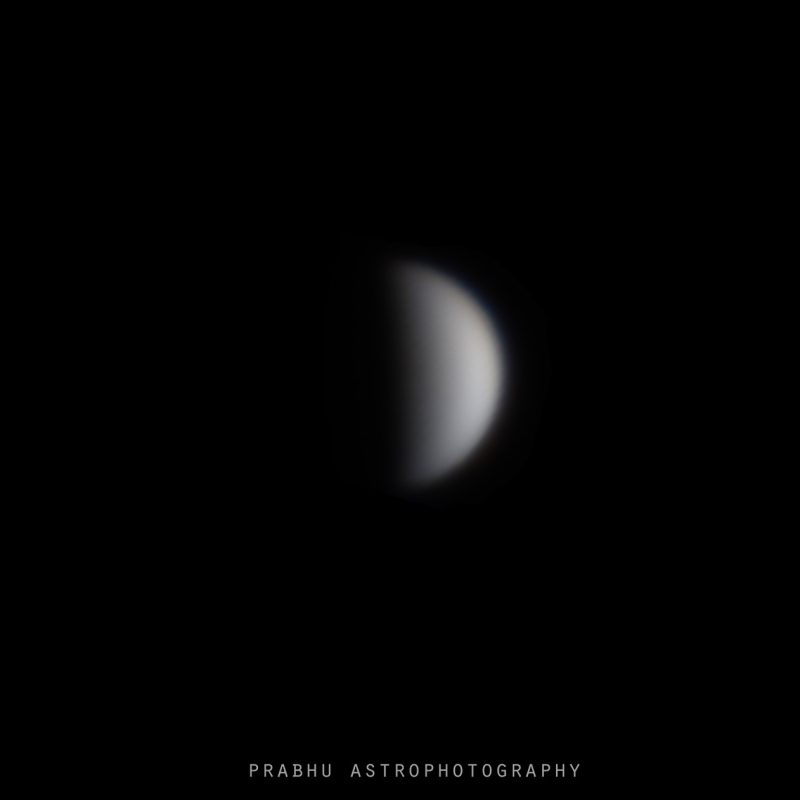
On September 11, 12 and 13, 2018, look west after sunset to spot the crescent moon, plus the planets Venus and Jupiter. You can’t miss them if your sky is clear! The moon, Venus and Jupiter rank as the 2nd brightest, 3rd brightest and 4th brightest sky objects, respectively, after the sun.
From approximately July 7 to September 7, 2018, Mars outshone Jupiter. This was the peak of a 15-year cycle for Mars, whereby its brightnesses waxes and wanes in our sky around the time Earth is passing between the sun and Mars. In 2018, Mars was brighter than it had been since 2003. It was brighter than Jupiter. Now, Jupiter has reclaimed its rank as 4th-brightest sky object.
By the way, you won’t have to wait 15 years to see Mars brighter than Jupiter again. Mars will briefly surpass Jupiter in brilliance again until late September 2020.
There are four planets in our evening sky now:

You can catch 4 bright planets at evening dusk. This chart covers more area than most of our charts do. Mars to Venus represents about 1/4th the way around the horizon. Venus sets first, followed by Jupiter, then Saturn and then Mars. Read more.
Be forewarned if you live at mid-northern latitudes (mainland United States, Europe, Japan). Throughout September 2018, Venus lurks very low in the sky at sunset and follows the sun beneath the horizon before nightfall. As far north as Situk, Alaska, the sun and Venus actually set at the same time on September 11. Farther north, Venus sets before the sun. Suffice it to say, folks at mid-northern latitudes cannot tarry if they want to catch Venus after sunset in September, 2018.
Meanwhile, in the Southern Hemisphere, Venus shines much higher up at sunset and stays out until well after dark. Chances are, from that hemisphere, Venus will be easily visible in the evening sky when Venus and Mercury have a conjunction on October 14, 2018.
But there’s more of interest about Venus now. If you can catch Venus in the evening sky now – and if you have a telescope – this is a great time to see Venus’ waning phase and increasing disk size through the telescope.
Yes, like a tiny moon, Venus changes phase. It will pass between us and the sun at inferior conjunction on October 26, 2018. Between now and then, telescopic viewers will see Venus’ crescent thinning, and also lengthening into a banana-shaped figurine that is easier to discern.

As Venus pulls up behind Earth in the race of the planets – preparing to pass between us and the sun on October 26, 2018, we see its phase shrink as its disk size enlarges. Image via Statis Kalyvis.

Prabhakaran A from Sharjah in the United Arab Emirates captured the planet Venus at greatest eastern elongation – 45.9 degrees from the sun on our sky’s dome – on August 17, 2018. We are able to see Venus and Mercury exhibit phases, because their orbits around the sun are inside the orbit of Earth. Thus, sometimes, their lighted faces are turned partly (or entirely) away from us.
On September 11-13, 2018, Venus’ disk appears to us to be approximately 33% illuminated in sunshine. By September 21, it’ll be about 25% illuminated. By mid-October, it’ll be 5% illuminated and about 1.7 times longer than the crescent on September 11. During the third week and into the fourth week of October 2018, the thin and long crescent may become visible in ordinary binoculars (or possibly the naked eye) from Earth’s Southern Hemisphere, where Venus will appear better placed for viewing, higher in the sky after sunset. Will we see this from the Northern Hemisphere? We’ll be looking at Venus lower in the sky, through a greater thickness of atmosphere. So the view won’t be as good. But, still, it’s always worth a try!
Find Venus’ current phase via U.S. Naval Observatory (click on Venus as your subject of interest)
As for Jupiter … it’s sinking into the sun’s glare, too. Like Venus, Jupiter will be gone by late October. Will these two have a conjunction before they disappear? No. Jupiter will follow Venus below the western horizon.
On September 11-13, Jupiter sets roughly an hour after Venus, and Jupiter’s four major moons – Io, Europa, Callisto and Ganymede – can still be seen through the telescope. Click here to find out the positions of Jupiter’s moons for right now or some chosen date.
Bottom line: These next few evenings – September 11 to 13, 2018 – use the waxing crescent moon to find the planets Venus and Jupiter.
Read more: How Jupiter’s moons reveal Jupiter’s mass
from EarthSky https://ift.tt/2oVgCvI

On September 11, 12 and 13, 2018, look west after sunset to spot the crescent moon, plus the planets Venus and Jupiter. You can’t miss them if your sky is clear! The moon, Venus and Jupiter rank as the 2nd brightest, 3rd brightest and 4th brightest sky objects, respectively, after the sun.
From approximately July 7 to September 7, 2018, Mars outshone Jupiter. This was the peak of a 15-year cycle for Mars, whereby its brightnesses waxes and wanes in our sky around the time Earth is passing between the sun and Mars. In 2018, Mars was brighter than it had been since 2003. It was brighter than Jupiter. Now, Jupiter has reclaimed its rank as 4th-brightest sky object.
By the way, you won’t have to wait 15 years to see Mars brighter than Jupiter again. Mars will briefly surpass Jupiter in brilliance again until late September 2020.
There are four planets in our evening sky now:

You can catch 4 bright planets at evening dusk. This chart covers more area than most of our charts do. Mars to Venus represents about 1/4th the way around the horizon. Venus sets first, followed by Jupiter, then Saturn and then Mars. Read more.
Be forewarned if you live at mid-northern latitudes (mainland United States, Europe, Japan). Throughout September 2018, Venus lurks very low in the sky at sunset and follows the sun beneath the horizon before nightfall. As far north as Situk, Alaska, the sun and Venus actually set at the same time on September 11. Farther north, Venus sets before the sun. Suffice it to say, folks at mid-northern latitudes cannot tarry if they want to catch Venus after sunset in September, 2018.
Meanwhile, in the Southern Hemisphere, Venus shines much higher up at sunset and stays out until well after dark. Chances are, from that hemisphere, Venus will be easily visible in the evening sky when Venus and Mercury have a conjunction on October 14, 2018.
But there’s more of interest about Venus now. If you can catch Venus in the evening sky now – and if you have a telescope – this is a great time to see Venus’ waning phase and increasing disk size through the telescope.
Yes, like a tiny moon, Venus changes phase. It will pass between us and the sun at inferior conjunction on October 26, 2018. Between now and then, telescopic viewers will see Venus’ crescent thinning, and also lengthening into a banana-shaped figurine that is easier to discern.

As Venus pulls up behind Earth in the race of the planets – preparing to pass between us and the sun on October 26, 2018, we see its phase shrink as its disk size enlarges. Image via Statis Kalyvis.

Prabhakaran A from Sharjah in the United Arab Emirates captured the planet Venus at greatest eastern elongation – 45.9 degrees from the sun on our sky’s dome – on August 17, 2018. We are able to see Venus and Mercury exhibit phases, because their orbits around the sun are inside the orbit of Earth. Thus, sometimes, their lighted faces are turned partly (or entirely) away from us.
On September 11-13, 2018, Venus’ disk appears to us to be approximately 33% illuminated in sunshine. By September 21, it’ll be about 25% illuminated. By mid-October, it’ll be 5% illuminated and about 1.7 times longer than the crescent on September 11. During the third week and into the fourth week of October 2018, the thin and long crescent may become visible in ordinary binoculars (or possibly the naked eye) from Earth’s Southern Hemisphere, where Venus will appear better placed for viewing, higher in the sky after sunset. Will we see this from the Northern Hemisphere? We’ll be looking at Venus lower in the sky, through a greater thickness of atmosphere. So the view won’t be as good. But, still, it’s always worth a try!
Find Venus’ current phase via U.S. Naval Observatory (click on Venus as your subject of interest)
As for Jupiter … it’s sinking into the sun’s glare, too. Like Venus, Jupiter will be gone by late October. Will these two have a conjunction before they disappear? No. Jupiter will follow Venus below the western horizon.
On September 11-13, Jupiter sets roughly an hour after Venus, and Jupiter’s four major moons – Io, Europa, Callisto and Ganymede – can still be seen through the telescope. Click here to find out the positions of Jupiter’s moons for right now or some chosen date.
Bottom line: These next few evenings – September 11 to 13, 2018 – use the waxing crescent moon to find the planets Venus and Jupiter.
Read more: How Jupiter’s moons reveal Jupiter’s mass
from EarthSky https://ift.tt/2oVgCvI

Aucun commentaire:
Enregistrer un commentaire